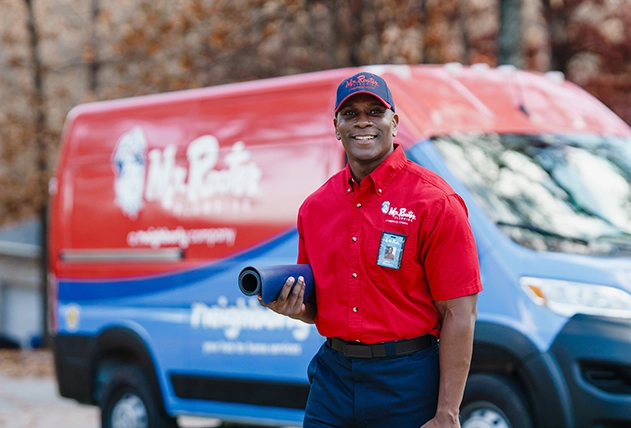If your toilet keeps running, try pouring water into the toilet bowl or tank after a good flush. Our handy guide is here to help you troubleshoot and fix the issue. It is a common problem that is likely to occur with your toilet at some point. And while it may not seem like a big deal, it can cost you money on your utility bill.
Our local Charleston plumbers are here to help. We've got seven simple steps to troubleshoot and fix your toilet that is constantly running. Don't worry, the chances your toilet needs to be replaced are low. And with some simple DIY steps, you can be well on your way to fixing the issue for yourself.
Mr. Rooter Plumbing of Greater Charleston will be there every step of the way, from start to finish. This guide should help you understand the inner workings of your toilet. Inside the tank are simple components that work together to flush and refill your toilet. This guide is primarily intended for traditional toilets, but the principles should be applicable to dual-flush systems as well. So read on to get started on fixing your running toilet.
The Steps You Should Take
Step 1: Locating the Water Supply
If your toilet keeps running after you flush, the first step to fix a toilet is always to turn off the water supply. Locate the water shutoff valve to stop water from running while working. It is typically near the base of the toilet. It may also be located behind the toilet. Turn it clockwise to stop the water flow. Now, press the flapper or flush the toilet to drain all the water from the tank. This will ensure you don't have a big mess on your hands.
Step 2: Removing the Tank Lid
The next step to fix a toilet that keeps running is to remove the lid from your tank. Be careful with it and set it aside on a safe, flat surface. Take a good look inside; you might be surprised at how few components there are, especially if you have a traditional style toilet. The components inside the toilet tank are as follows:
- Flush Valve: Located at the bottom of the tank. It is the opening through which water flows into the bowl.
- Flapper or Tank Ball: The flapper is a flexible rubber seal that covers the flush valve. When the handle is pressed, it lifts. Older toilets use a tank ball; it works similarly, but is a ball attached to a rod.
- Fill Valve (Ballcock) and Fill Tube: This valve controls water flow after flushing. It is regulated by a float that rises with the water level to shut off the valve when the tank is full. The tube directs water into the overflow tube to refill the tank.
- Float: Attached to the valve, it rises with the water level in the toilet tank to shut off water at a preset height.
- Overflow Pipe: A vertical tube inside the tank that directs water in the tank into the bowl in case of overflow.
- Toilet Chain and Lift Wire: The chain connects the flush handle to the flapper.
Step 3: Inspect and Replace the Flapper
If your toilet is running after you flush, it may be due to an old flapper. Check the flapper and the seat for signs of mineral deposits or roughness. You can clean it with a scrub pad if needed. If it is damaged, install a new flapper by attaching it to the overflow tube and reconnecting the chain. Check if the chain has enough slack to seal properly. Turn the water supply back on. Flush the toilet and check for leaks. If the toilet sounds like it's still running, unfortunately, this didn't fix the problem.
Step 4: Check the Overflow Tube
Located at the center of the tank, the overflow tube could be too short or cracked. If it is, it may need to be replaced if your toilet won't stop running. You should also ensure the refill tube is clipped to the overflow tube. And that it is not too far down, as it can siphon water and keep your toilet running.
Step 5: Inspect and Adjust the Fill Valve
The fill valve, which is regulated by either a float ball or a float-cup valve, depending on the age of your toilet, may be the cause of your running toilet. To adjust the float of a valve, turn the adjustment screw on the fill valve clockwise to raise it or counterclockwise to lower it. The water level should be about 1 inch below the top of the overflow tube.
For old toilets and old fill valves, you need to gently bend the float arm to get to the correct water level. This is a common fix to stop a running toilet. Now, give it a flush and check the water level in the tank and adjust as needed. A new fill valve can also fix the problem if yours is damaged.
Step 6: Inspect the Handle and Chain
Another issue that could be causing your toilet to run constantly is the handle or chain. If the handle is loose, it could be the cause of gallons of water being wasted every night. Tighten the mounting nut inside the tank with a wrench or pliers. Avoid overtightening to prevent cracking the porcelain. If it still doesn't move the toilet flapper when you flush, you may need to replace it by removing the chain, unscrewing the nut, and installing the new flush lever as per the instructions that came with the kit. Adjust the chain connected to the flapper and ensure there is about an inch of slack.
Step 7: Some Additional Checks
If following these steps doesn't fix your toilet that runs, inspect the flush valve seat. Repair kits are available to remedy the issue. Another potential cause of a running toilet problem is that your fill valve needs to be replaced.
Choose Mr. Rooter Plumbing for Reliable Toilet and Plumbing Repair Today
We hope you enjoyed this guide on how to stop a toilet from running. Everything from the flapper and its seat to the toilet tank float could be causing your problems. Remember to always shut off the water valve before attempting to fix a running toilet. If, for some reason, this did not resolve your issue, you can count on Mr. Rooter Plumbing of Greater Charleston to help you save water and money on your water bill.
We offer a wide range of plumbing services, including new toilet installation, drain cleaning, leak detection, sink repair, and toilet repair, and more. We can fix a variety of common toilet issues. Our team can replace your toilet fill valve, remove the old flapper and install a new one, or even replace your entire toilet if necessary. Addressing toilet issues is just one of our specialties. Avoid water waste and enjoy a reliable toilet today.
Contact us to schedule your plumbing appointment. We'll make sure your toilet's next flush isn't its last.

